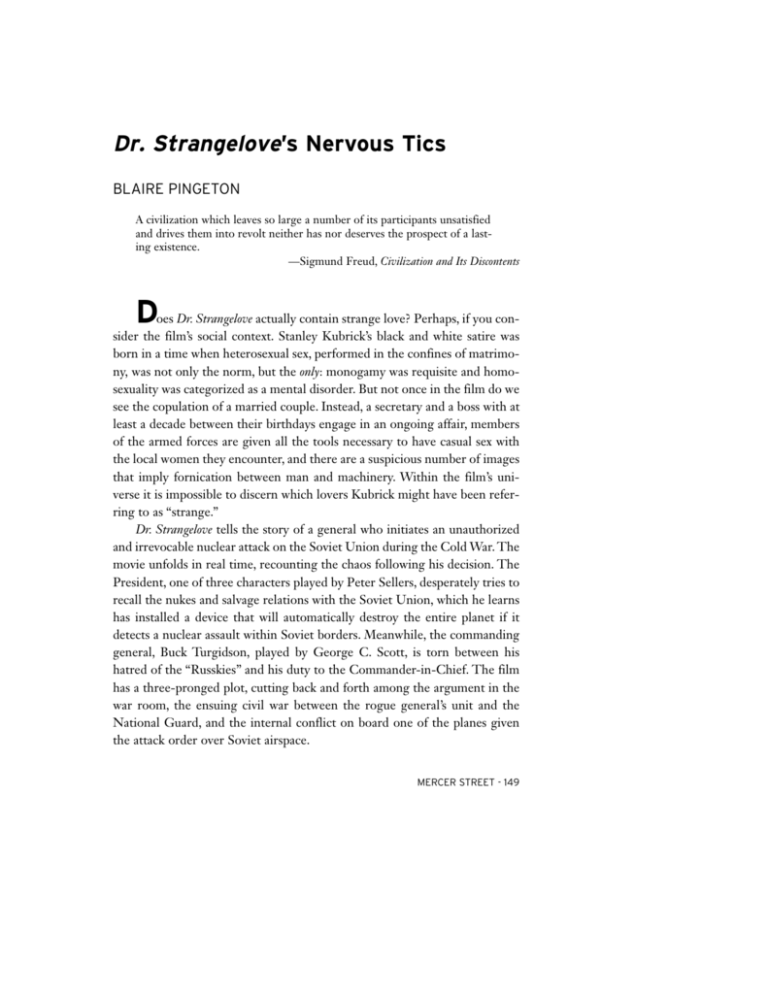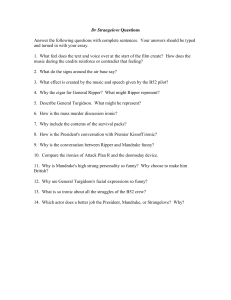
Dr. Strangelove’s Nervous Tics
BLAIRE PINGETON
A civilization which leaves so large a number of its participants unsatisfied
and drives them into revolt neither has nor deserves the prospect of a lasting existence.
—Sigmund Freud, Civilization and Its Discontents
D
oes Dr. Strangelove actually contain strange love? Perhaps, if you consider the film’s social context. Stanley Kubrick’s black and white satire was
born in a time when heterosexual sex, performed in the confines of matrimony, was not only the norm, but the only: monogamy was requisite and homosexuality was categorized as a mental disorder. But not once in the film do we
see the copulation of a married couple. Instead, a secretary and a boss with at
least a decade between their birthdays engage in an ongoing affair, members
of the armed forces are given all the tools necessary to have casual sex with
the local women they encounter, and there are a suspicious number of images
that imply fornication between man and machinery. Within the film’s universe it is impossible to discern which lovers Kubrick might have been referring to as “strange.”
Dr. Strangelove tells the story of a general who initiates an unauthorized
and irrevocable nuclear attack on the Soviet Union during the Cold War. The
movie unfolds in real time, recounting the chaos following his decision. The
President, one of three characters played by Peter Sellers, desperately tries to
recall the nukes and salvage relations with the Soviet Union, which he learns
has installed a device that will automatically destroy the entire planet if it
detects a nuclear assault within Soviet borders. Meanwhile, the commanding
general, Buck Turgidson, played by George C. Scott, is torn between his
hatred of the “Russkies” and his duty to the Commander-in-Chief. The film
has a three-pronged plot, cutting back and forth among the argument in the
war room, the ensuing civil war between the rogue general’s unit and the
National Guard, and the internal conflict on board one of the planes given
the attack order over Soviet airspace.
MERCER STREET - 149
Kubrick, in full satirical mode, hides many of his ideas in the subtext of
the film rather than laying them out directly in the plot and dialogue. He
seems to take none of his characters seriously; even after dozens of viewings,
it seems likely, to the attentive audience member, that the actors will burst
into laughter, point at the audience and wink “gotcha” at any given moment.
Instead of investing in his characters sincerely, Kubrick uses them as vehicles
to relay messages that are quite different from the ones presented on the surface of the film. If someone says white, Kubrick is screaming black. The most
pointed—and simultaneously complex—references are the film’s allusions to
homosexuality. In keeping with the status quo of 1960’s American culture,
nobody is openly gay in the film, but time and time again Kubrick whispers
hints of repressed homosexuality. The characters with the most aggressive
suggestions of latent homosexuality are the ones who cause destruction.
Sexual frustration begets the chaos of the film.
Kubrick’s tentative, subtle approach to gay characters is not without
legitimate grounds. America in the 60’s was not a safe place to be gay, nor was
it an environment conducive to discussions about homosexuality. Sodomy
was illegal across the nation until 1962, when Illinois became the first state to
lift its discriminatory legislation; it was not until the 2003 case, Lawrence vs.
Texas, that the Supreme Court deemed it unlawful to ban homosexual intercourse (Gibbs). Furthermore, the American Psychological Association, currently the largest association of psychologists worldwide, categorized homosexuality as a mental illness in the 1952 and 1968 editions of its Diagnostic and
Statistical Manual of Mental Disorders. The “condition” was thought to stem
from family dynamics and a mixed sense of gender-identity (Glassgold 22).
A few decades earlier, Germany, under the Nazis, had taken a more
deliberate and aggressive approach to shunning homosexuality. According to
the United States Holocaust Memorial Museum, the Third Reich did not
“seek to kill all homosexuals,” but “nevertheless, the Nazi state, through
active persecution, attempted to terrorize German homosexuals into sexual
and social conformity, leaving thousands dead and shattering the lives of
many more” (“Nazi Persecution”). The state meant to scare its gay citizens
out of their sexual orientation, and American culture sent something of a similar, but less lethal, message to its homosexual populace: conform or suffer.
This tremendously stifling environment is a powerful manifestation of
Freud’s famous concept of the death drive, which he outlined thirty years
prior to the release of Dr. Strangelove in his most ambitious work of cultural
criticism, Civilization and Its Discontents. Writing on the eve of World War II,
Freud contends that human beings have two instinctual paths: the life drive
150 - MERCER STREET
(Eros), which pushes a person toward sexual intercourse, toward combining
“organic substances into ever larger unities,” and the death drive, which is an
instinct to return “to an inorganic state” (qtd. in Menand 18). This “inorganic state,” known colloquially as death, can manifest itself in self-harm, such as
suicidal or masochistic tendencies, or in aggression toward others. The two
types of violence are deeply linked, as Louis Menand explains: “Sadism is . . .
a redirection of a more primary impulse, masochism. We hurt others instead
of ourselves because we wish to live a little longer, so that we may die on our
own terms” (18-19). The death drive is a violent impulse brought on when
someone subconsciously feels that he is not in control of his primary reproductive instincts. In response to this frustration, he absorbs himself in sexuality’s counter-instinct: a return to the earth and anonymity, a flight into death.
Freud outlines a basic dichotomy, arguing that the happiness of individual men and women and the success of civilization as a whole are at odds. A
man cannot, particularly within the confines of Western civilization, fulfill
both his sexual desires—his libido—and conform to the necessary social standards. Freud laments that “the requirement . . . that there shall be a single
kind of sexual life for everyone disregards the dissimilarities, whether innate
or acquired, in the sexual constitution of human beings”; it restricts “a fair
number . . . from sexual enjoyment, and so becomes a serious injustice” (94).
This injustice is necessary for civilization to function, because “a pair of lovers
is sufficient to themselves” while a civilization “aims at binding the members
of the community together in a libidinal way . . . and employs every means to
that end” (99). Western civilization’s sexual restrictions are rooted in the core
insecurity that faces all civilizations: the problem of convincing a person to
donate his life to the community, rather than keeping to himself and his own
happiness. The death drive is a rebellion against civilization’s sexual regulation.
In Dr. Strangelove, the dire fate of the world can be blamed on three characters working under the influence of their death drives: Major Kong, the
captain of the only airplane that successfully drops its missiles on the Soviet
Union; Dr. Strangelove himself, the scientist who developed the technology
of total annihilation that the Soviets have implemented; and General Ripper,
the commanding officer who authorizes the attack order. Kubrick uses both
imagery and dialogue to allude to the three characters’ homosexual tendencies. The most obvious visual suggestion comes at the very end of the film, in
the few seconds before the end of the world. Major Kong, desperate to carry
out his mission despite the rebellion of the bombs themselves, descends into
the holding area and attempts to hard-wire them into action. The final
MERCER STREET - 151
moments of the film oscillate wildly among a series of images: a cartoonish
shot of the plane, grossly out of proportion, continuing through Siberia; a still
shot of a radar screen, which tracks the distance between the plane and the
impending fate of the world; a control man carrying out the final procedures
that facilitate the dropping of the bomb; and Major Kong, remaining lazymouthed, goofy, and idiotic throughout. He bats away at the missile with his
cowboy hat. When the missiles finally comply, Major Kong sits on the tip of
the nuke and rides into the Russian countryside, waving his cowboy hat and
gyrating against the tip of the missile enthusiastically. Joy saturates his face.
The missile is obviously phallic, and the positioning of Major Kong is such
that one cannot help but associate the image with homosexual intercourse.
The only images after this striking scene are of explosions, which no less
explicitly suggest an orgasm. This scene unites the life and death drives. More
precisely, Major Kong converts his thwarted sex drive into a drive for destruction. As he rides “triumphantly” unto his death, Kong controls his return “to
an inorganic state” and enacts vengeance against civilization—not just his civilization, but all civilization (Freud qtd. in Menand 18).
Dr. Strangelove himself is a pervert. We don’t know he is a pervert, but
Kubrick frames him—and names him—in a way that unmistakably suggests
it. Watching him produces an indescribable level of discomfort. His body is
contorted around the wheelchair he uses, his neck and chin are crumpled
against his chest, his eyes are opened too wide, and he seems to chew each
word before spitting it out. Kubrick deliberately highlights his obscenity by
isolating him: wherever Dr. Strangelove appears, he is shrouded, with shadows cast over his face that seem particularly eerie because of the black and
white aesthetic. Even the fiercest partisans in the war room collude on the
doctor’s idiosyncratic behavior.
Kubrick and Sellers’s calculated portrayal of Dr. Strangelove suggests
physical, bodily isolation. And the character is also a figure of manifest repression—repression, perhaps, of homosexual tendencies. Dr. Strangelove has an
uncontrollable impulse that randomly causes him to perform the Nazi salute.
We can read this, especially in light of his other eccentricities, as a kind of
transgressive erection. Dr. Strangelove’s arousal is unvarying, unmanageable,
and powerful, yet the environment—the war room, the only room where we
see him, a room populated strictly by men—demands that he repress it. It is
men who arouse Dr. Strangelove’s arm in the first place. His odd bodily tics
speak of thwarted desires.
General Jack Ripper explains that his intense hatred of the Soviet
Union—a hatred powerful enough to justify nuclear war—is driven by the
152 - MERCER STREET
Russian plans to infiltrate American water systems with fluoride.
“Fluoridation,” he explains, with a seriousness so profound it could quell the
giggles of a toddler on laughing gas, “is the most monstrously conceived and
dangerous communist plot we have ever had to face.” The only time we see
the General break is when his distressed Group Captain asks him about the
development of this theory. The two sit in the General’s office, which is now
torn apart by stray bullets; the General’s focus fumbles, and for the first time
he trips over his words: “Well . . . I . . . uh . . . I . . . f-f-irst became aware,
Mandrake, during the . . . uh . . . physical act of love. Yes . . . a . . . uh . . . profound sense of fatigue, a feeling of emptiness followed.” The mask he has
been wearing breaks down. Until this moment, the General has maintained a
placid and unquestioning expression: the wrinkles on his forehead have
seemed purposeful, and his mouth has moved only when necessary to form
each syllable of each word of command. But the broken General that we confront late in the film, after this confession—the planes of his face changed, his
eyes glazed—is most revealing. The General has issued destructive orders
with total assurance and attacked his own troops with all the ease of a man
dealing a deck of cards. We are called on by Kubrick to see that Ripper’s rage
for destruction stems from an insane notion about fluoride that came to him
during intercourse. Ripper cites a “loss of essence” due to fluoridation, as the
reason for his sexual frustrations, but we have no need to indulge his denial
(Dr. Strangelove). Sexual confusion, sexual repression, sexual misunderstanding—these forces are so substantial that the General is willing to destroy the
entire planet to avoid facing them.
Dr. Strangelove is a dramatic staging of Freud’s death drive. It is like an
inverted Oedipus Rex: rather than theater giving birth to theory, Freud’s theory informs Kubrick’s theater. Kubrick neither champions nor chides homosexuality itself, but warns against the implications of suffocating or failing to
recognize natural impulses.
In a letter to the distraught mother of a homosexual son, Freud writes:
Homosexuality is assuredly no advantage, but it is nothing to be ashamed
of, no vice, no degradation, it cannot be classified as an illness; we consider
it to be a variation of the sexual function produced by certain arrest of sexual development. Many highly respectable individuals of ancient and modern times have been homosexuals, several of the greatest among them
(Plato, Michelangelo, Leonardo da Vinci, etc.). It is a great injustice to persecute homosexuality as a crime, and cruelty too. (“Letter”)
MERCER STREET - 153
Dr. Strangelove tries Western culture for this crime—or at least shows us the
potential repercussions of sexual repression. We dig our own graves by turning away from the life forces. The drive toward honest consummation is basic
to any person, any human brain; it is the instinct that perpetuates life itself.
But what option does one have when this drive is repressed, thwarted?
Sex with a bomb. Or something like that.
WORKS CITED
“About APA.” American Psychological Association. Web. 10 May 2010.
Dr. Strangelove or: How I Learned to Stop Worrying and Love the Bomb. Dir.
Stanley Kubrick. Perf. Peter Sellers, Sterling Hayden, Slim Pickens.
Columbia, 1964. Film.
Freud, Sigmund. Civilization and Its Discontents. New York: Norton, 2005.
Print.
—. “Letter to an American Mother.” American Journal of Psychiatry 107.10:
786-87. Baltimore: American Psychiatric Association, 1951. Print.
Gibbs, Nancy. “A Yea For Gays.” Time. 17 July 2003. Web. 1 Apr. 2010.
Glassgold, Judith M. et al. “Report of the American Psychological
Association Task Force on Appropriate Therapeutic Responses to
Sexual Orientation.” Washington: APA, 2009. Print.
Menand, Louis. Introduction. Civilization and Its Discontents. By Sigmund
Freud. London: Norton, 2005. 9-32. Print.
“Nazi Persecution of Homosexuals 1933-1935.” United States Holocaust
Memorial Museum. Web. 23 Mar. 2010.
154 - MERCER STREET







